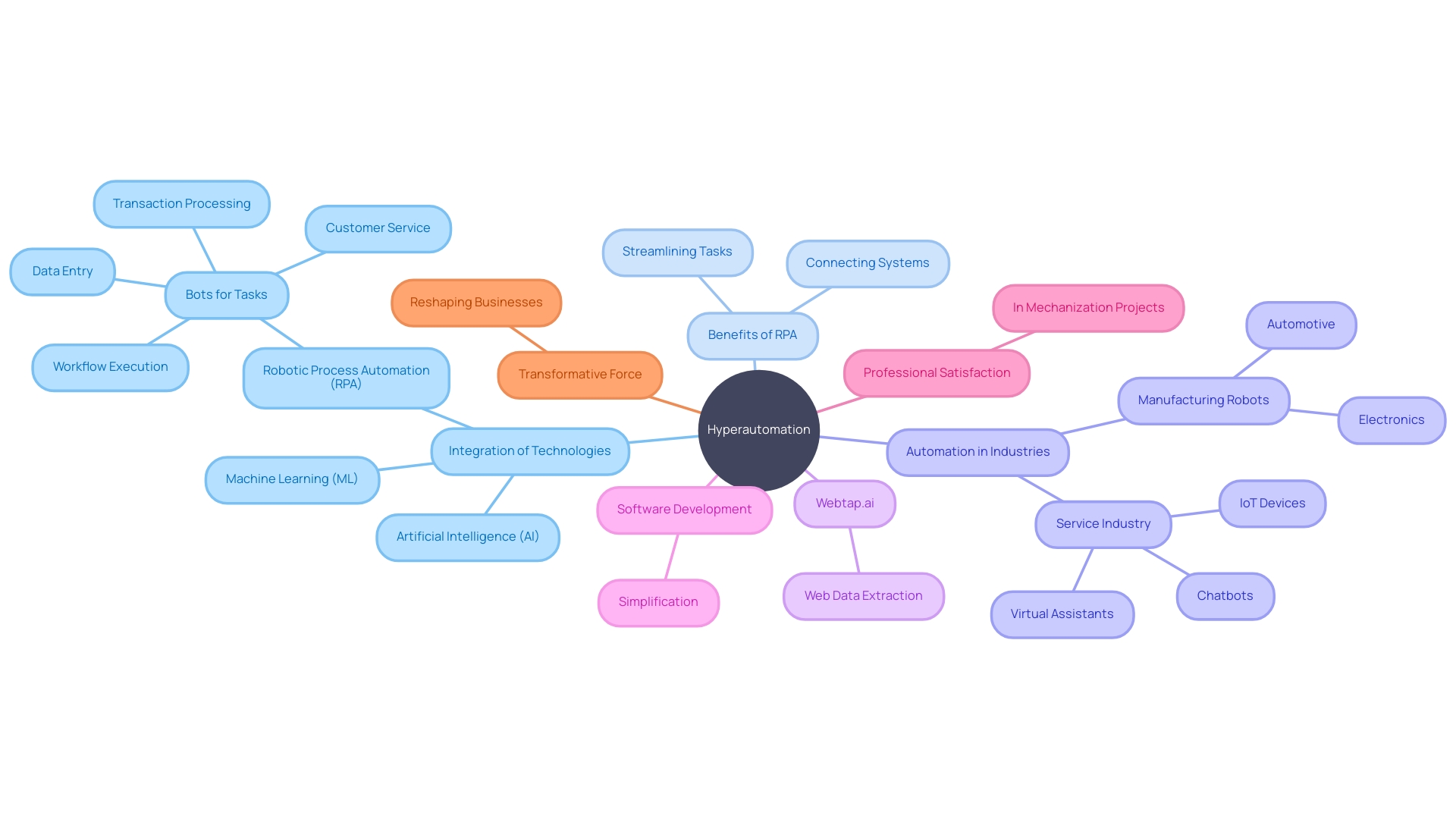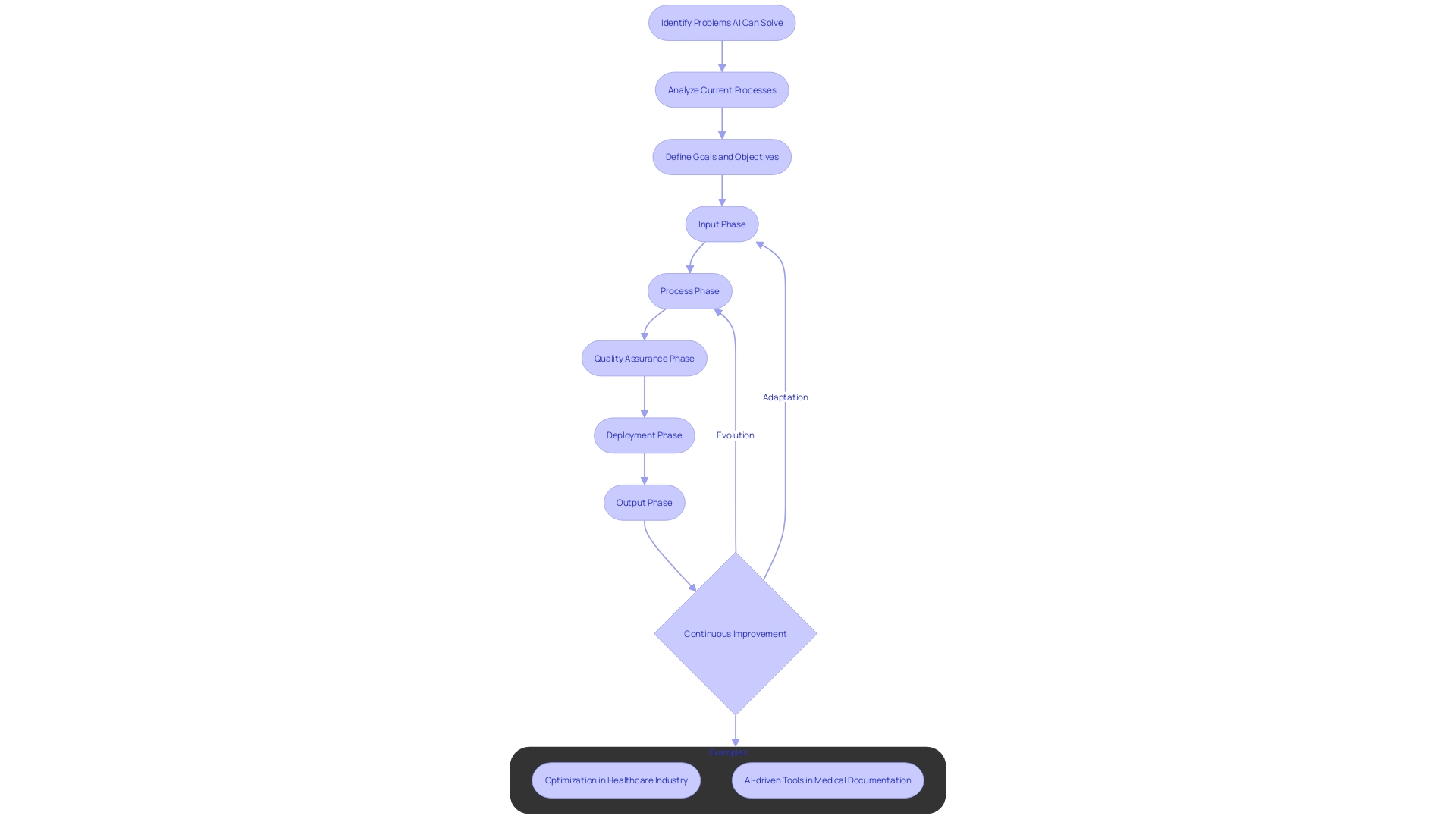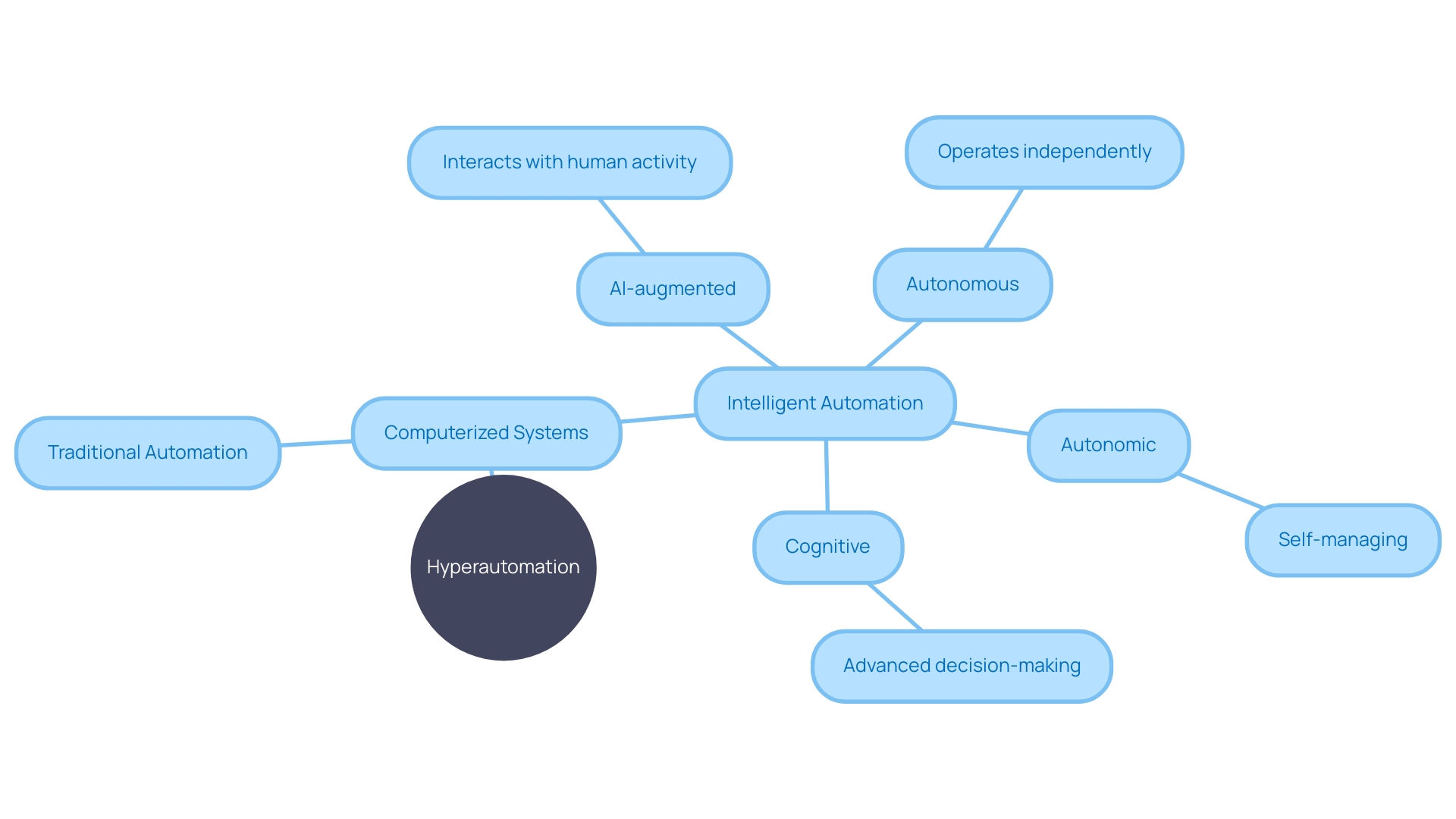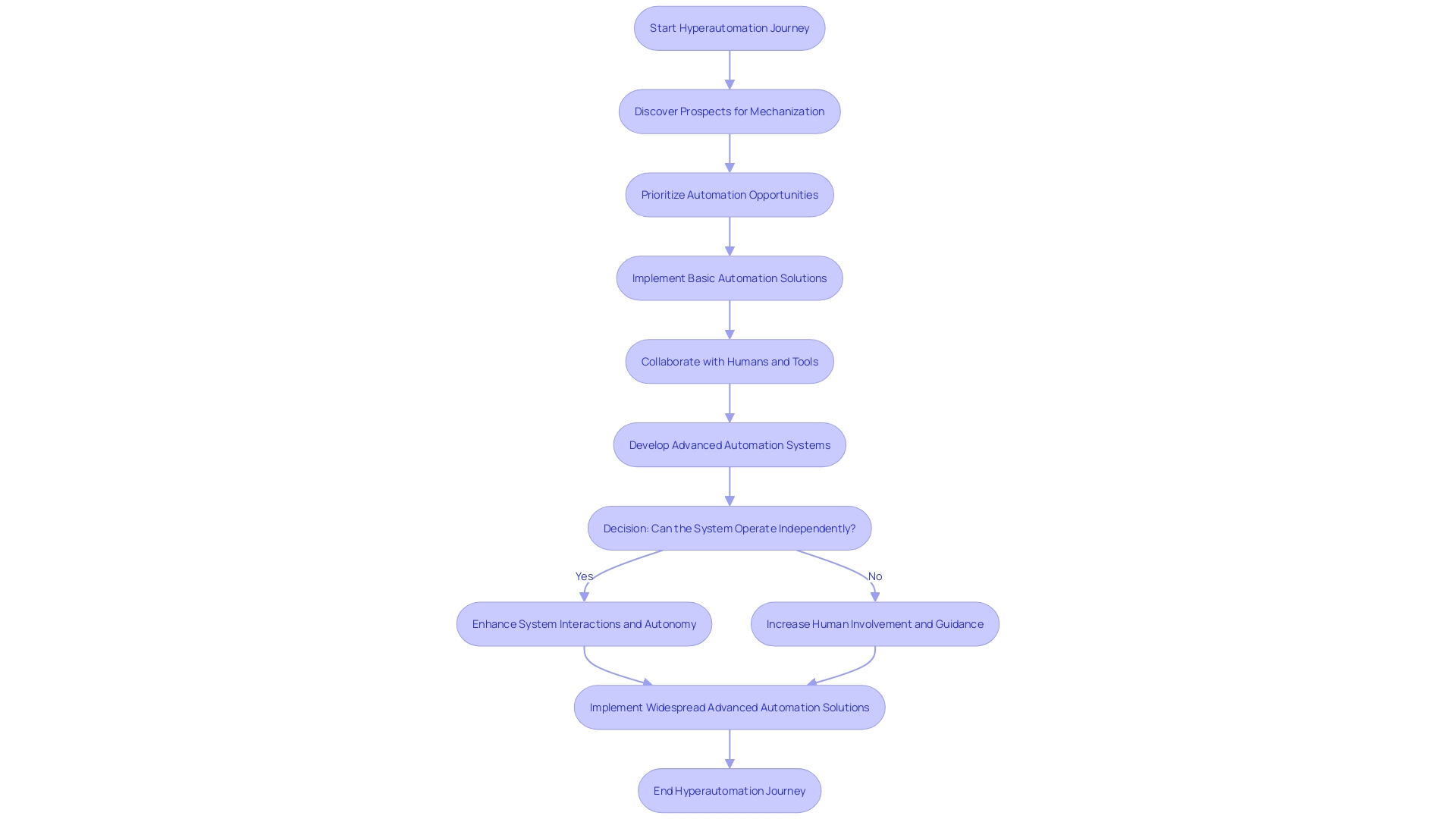Introduction
Hyperautomation, the integration of artificial intelligence (AI), machine learning (ML), and Robotic Process Automation (RPA), is revolutionizing business processes by elevating operational efficiency. Unlike traditional automation methods, hyperautomation can tackle complex tasks that were once difficult to automate. With the synergy of AI and RPA, companies like Holiday Extras and Summer Health have streamlined operations and improved productivity.
Hyperautomation also leverages advanced technologies such as natural language processing and process mining, enabling businesses to extract critical data and gain insights for enhanced efficiency. By embracing hyperautomation, organizations can experience increased efficiency, enhanced productivity, improved accuracy, cost savings, scalability, and gain a competitive advantage. As hyperautomation reshapes the way businesses operate, it is crucial for organizations to understand its benefits and consider its implementation as part of a broader digital transformation strategy.
What is Hyperautomation?
Hyperautomation represents the pinnacle of business process innovation, integrating cutting-edge artificial intelligence (AI), machine learning (ML), and Robotic Process Automation (RPA) to elevate operational efficiency. Unlike its previous iterations, hyperautomation is skilled at addressing intricate tasks that once defied efforts to automate. It achieves this through the application of sophisticated AI and ML algorithms, enabling data analysis, decision-making, and proactive action-taking, all of which contribute to heightened productivity.
- Robotic Process Automation (RPA) is revolutionizing the way we handle repetitive tasks. It empowers software robots to mimic human actions in data entry, workflow execution, and customer service. The integration of systems through RPA can free employees from repetitive tasks, unleashing the full potential of the automated processes.
Using the synergy of AI and RPA, companies like Holiday Extras streamline tasks across multiple markets and enhance data fluency among non-technical staff, overcoming linguistic and data analysis barriers. Similarly, healthcare providers like Summer Health utilize automation to reduce the administrative burden on pediatricians, thereby improving patient care and reducing professional burnout.
- The introduction of Webtap.ai marks a significant milestone in web data extraction. By utilizing natural language processing, professionals can now collect essential data effortlessly, strengthening the role of automated processes in big data analysis and its invaluable contribution to operational efficiency.
- “The idea is based upon workflows and actions,” as experts note, hyperautomation simplifies software development by reducing complexity. It allows for the creation of powerful, actionable sequences in a fraction of the time it would take with traditional coding.
Reports emphasize an increasing contentment among professionals involved in mechanization projects. Hyperautomation is not only streamlining operations but also providing learning opportunities and career growth for those involved in the field, as evidenced by the State of the Automation Professional Report.
Hyperautomation, through its AI and RPA components, is not just a trend; it’s a transformative force reshaping the way businesses operate, enabling them to address challenges that seemed insurmountable before.

How is Hyperautomation Different from Traditional Automation?
Hyperautomation represents a revolutionary leap beyond traditional mechanization, incorporating artificial intelligence (AI) and machine learning (ML) to enhance its capabilities. Unlike conventional automation, which is hard-coded to perform specific functions, AI algorithms empower it to adapt and evolve in response to new scenarios without human intervention. This sophisticated approach not only automates simple tasks but also orchestrates complex workflows across an array of systems, departments, and technologies. For example, in the healthcare industry, the use of advanced automation can optimize the acquisition and implementation of digital technologies, guaranteeing secure, suitable, and compliant solutions.
In medical documentation, for example, pediatricians no longer need to manually transcribe notes; instead, AI-driven tools can assist in generating comprehensive summaries, freeing up valuable time for patient care. This is indicative of the broader trend of hyperautomation enabling professionals to focus on more strategic tasks by reducing the administrative burden.
A study conducted by TechRepublic emphasizes the different understandings of mechanization throughout businesses, underscoring that the primary objective is to mechanize the most beneficial operations to enhance customer interactions, increase sales, and enhance efficiency. Nevertheless, obstacles like competency deficiencies, technological restrictions, and cybersecurity anxieties may impede the implementation of enterprise-wide IT automation. Despite these obstacles, the integration of AI with automated technologies like SS&C Blue Prism’s document process automation, described as a ‘game-changer’, exemplifies the potential of hyperautomation to revolutionize traditional processes.
Grasping the intricacies of AI and machine-driven processes is crucial for organizations seeking to navigate the changing work environment. While automation has historically been used for repetitive tasks, the advent of AI has dramatically broadened the scope of potential applications, promising a future where the synergy between these technologies catalyzes innovation and efficiency.

Technologies Involved in Hyperautomation
Hyperautomation stands at the forefront of operational advancement, blending an array of technologies to streamline and enhance processes. One of its foundational technologies, Robotic Process Automation (RPA), empowers organizations to liberate personnel from monotonous, rule-bound tasks by replicating how humans interact with digital systems. This not only boosts productivity but also allows employees to focus on more strategic activities.
Artificial Intelligence (AI) brings further sophistication to hyperautomation by integrating machine learning (ML) and natural language processing. These AI components enable systems to discern patterns, execute decision-making, and undertake complex cognitive tasks that were traditionally the domain of human intellect.
Machine Learning algorithms take this a step further, learning from vast datasets to anticipate outcomes and refine operational performance continually. Companies like Holiday Extras, which operates across multiple European markets, harness AI to manage diverse tasks like translating marketing copy into various languages, showcasing AI’s versatility in handling scale and complexity.
Process Mining emerges as another pivotal technology, offering deep insights into workflows. By analyzing and depicting business procedures, it reveals inefficiencies and clears the path for optimizing operations. For example, Louvre Hotels Group witnessed a significant decrease in the time spent on rate code maintenance by integrating mining techniques, saving hundreds of hours per month and highlighting the tangible benefits of hyperautomation.
Moreover, the rise of Low-Code App Development platforms is a game-changer, enabling rapid, custom software creation with minimal coding effort. This speeds up the process of streamlining, enabling organizations to quickly adjust to market demands. Kabannas, an up-and-coming UK hotel group, leveraged this technology to empower guests, offering them control over their digital interactions with the hotel, which is especially crucial outside conventional business hours.
The deployment of these technologies is not limited to specific sectors; it’s a global phenomenon. In the UK, AI trials in public transportation have demonstrated potential in improving safety and operational efficiency. At the same time, the service industry experiences a surge in the use of chatbots and virtual assistants, showcasing the widespread acceptance of these technologies.
It’s important to note that while automation can occasionally displace jobs, it more often creates new opportunities and enhances existing roles, as indicated by the International Federation of Robotics’ report on the surge of industrial robots. The ultimate objective of the process of full automation is not to substitute the human labor force but to enhance it, guaranteeing that enterprises stay competitive and innovative.

Benefits of Hyperautomation
Embracing hyperautomation is a strategic move for businesses aiming to enhance their operational capabilities. It is not only about the mechanization of tasks but the coordination of methodologies and technologies, resulting in a transformative effect on efficiency and productivity.
- Increased Efficiency: Hyperautomation goes beyond simple task automation by integrating AI and ML algorithms, streamlining processes that once required extensive human intervention. This integration leads to a reallocation of resources, allowing employees to engage in strategic activities that add greater value to the company.
- Improved Efficiency: With the capability to automate intricate workflows and data-based tasks, the enhanced productivity drastically diminishes manual errors and processing durations. This leads to a more productive and agile organization, capable of responding swiftly to market changes and internal demands.
Enhanced Precision: The accuracy of AI and ML in advanced automation systems ensures tasks are performed consistently and correctly, minimizing the risk of errors that can arise from manual processing and offering a reliable level of quality control.
- Cost Savings: By reducing the dependence on manual labor and improving operational efficiencies, the use of advanced automation can drive down costs. This allows businesses to reallocate financial resources towards innovation and growth initiatives.
As operational demands grow, the scalable nature of this approach provides the ability to handle increased workloads without compromising on performance or quality, ensuring the organization can expand its capabilities as necessary.
Companies that implement advanced automation can deliver services more efficiently and effectively, gaining a competitive edge in the market. This advantage is evident in the ability to meet customer expectations with speed and precision.
Case studies, like the one of Holiday Extras, showcase the practical benefits of advanced automation. With a diverse customer base and a need for multi-language marketing copy, automation has enabled them to streamline operations and overcome the challenges of scale. Similarly, Summer Health’s use of hyperautomation in generating medical visit notes has freed pediatricians from administrative burdens, allowing them to dedicate more time to patient care.
Recent developments in RPA and AI technologies, as highlighted by experts such as Segura from SS&C Blue Prism, are transforming the manner in which organizations tackle mechanization. These technologies are now capable of extracting and structuring data, driving activities that were once too complex for traditional automation tools.
In the context of public transport, trials of AI technology in UK train stations have demonstrated the potential for enhanced safety and operational efficiency, while the TSA’s facial recognition program in the US aims to streamline security processes. These examples highlight the transformative nature of automation across various industries.
To remain competitive in a rapidly changing market, it is crucial for companies to grasp the entire range of advantages offered by advanced automation and to contemplate its integration as a component of a more comprehensive digital transformation plan.
Workflow Automation and Low-Code App Development
Embracing workflow mechanization is similar to setting the gears of hyperautomatization into motion. It’s where the orchestration of intricate processes comes to life, bridging gaps between disparate tasks, data silos, and system functionalities across varying departments and technological frameworks. The essence of low-code development platforms is found in their ability to democratize app creation. By offering a visual interface, these platforms empower those without extensive technical expertise to craft custom applications with only a minimum reliance on coding. This not only accelerates the digitization of workflows but also empowers business users to drive innovation, fostering a culture of proactive engagement in their efforts.
TotalEnergies Digital Factory (TDF), a wholly-owned subsidiary of TotalEnergies, stands as a testament to the transformative power of such technologies. With a mission to support the company’s strategic shift and digital metamorphosis, TDF has rolled out over 80 tailored digital solutions across 25 countries, revolutionizing legacy systems through the strategic use of APIs. Meanwhile, educational institutions like the Department of Electronic & Electrical Engineering are leveraging these tools to streamline administrative tasks such as managing personal tutorials and tracking student attendance, as highlighted by Emma Davies, the Department Coordinator.
The rise of low-code automation has been a game-changer in application development. It slashes the timeline for software deployment, as traditional coding practices, which are often intricate and lengthy, give way to rapid and responsive development cycles. This paradigm shift is not only about speed but also about sustainability, as Peter Tubak from Messe Munchen GmbH suggests, urging the integration of conventional software development wisdom to ensure that low-code solutions are robust and maintainable in the long haul.
Business management software (BPM) further complements this landscape by offering analytical insights into operational workflows, allowing organizations to identify areas ripe for improvement. As the demand for such tools escalates, solutions like Jira Work Management are rising to prominence, catering to both fledgling startups and established enterprises eager to refine their processes.
The advantages of workflow mechanization and low-code platforms are supported by convincing figures. A study deploying Forrester’s Total Economic Impact methodology reveals that investments in intelligent automation can lead to a stunning 73% net present value (NPV) revenue increase and a 5.4% compound annual growth rate (CAGR) over a span of three years. Such statistics not only quantify the value of these technological advancements but also serve as a clarion call for enterprises to adopt and adapt to the digital era.
AI-Powered Decisioning and Robotics
Hyperautomation combines the cognitive capabilities of AI with robotics to revolutionize how organizations make decisions and perform tasks. By integrating AI algorithms, systems become adept at analyzing data, leading to more accurate and rapid decision-making that parallels human intellect. This innovation is pivotal in refining complex decision-making processes that are essential to the strategic, operational, and tactical facets of a business. Robotics within hyperautomation predominantly employs software robots, or bots, to streamline repetitive and rule-guided tasks. These bots seamlessly interact with diverse systems and data sources, thereby facilitating automation across entire workflows. The advancement of AI in the domain is remarkable, with the quantity of scientific publications on AI and ML growing at an unparalleled pace, effectively doubling every two years. This fast expansion emphasizes the need for tools like Science4Cast, which forecast future AI research trends, ensuring that organizations stay at the forefront of technological advancements. Moreover, comprehending the impact of AI and automation on decision-making procedures is crucial. As highlighted by recent studies, global trust in AI varies significantly, which can affect the adoption rate of AI in decision-making and consequently influence a nation’s competitive edge in technology. With AI-driven insights, companies can innovate and maintain a strategic advantage, ensuring their operations remain competitive and aligned with the latest technological breakthroughs.
Process Mining and Insights
Hyperautomation leverages process mining to delve into the intricacies of operational activities. By collecting information from diverse sources such as transaction logs, this method applies sophisticated algorithms to uncover, monitor, and enhance business operations. The insights obtained from mining shed light on the effectiveness of the operation, bottlenecks, and opportunities for improvement, guiding organizations towards data-driven decisions to enhance their operations and improve overall performance. For instance, companies like ICL, which faces challenges in monitoring machinery under extreme conditions, can greatly benefit from this technology. They can obtain almost real-time visibility into their workflows, which is essential for enhancing operations and making well-informed decisions. Furthermore, mining can tackle particular problems like credit blocks in the order-to-cash operation, decreasing delays in order fulfillment for trustworthy clients and shortening the time to resolve such blockages.
Moreover, combining IoT and advanced analytics with mining allows enterprises to enhance their workflows seamlessly. As shown in the case of UK train stations using AI to boost safety and operational efficiency, the potential of these technologies to revolutionize business processes is vast. Meanwhile, companies like OnProcess are demonstrating how supply chain operations can serve as a strategic advantage, emphasizing the importance of efficiency and resilience in today’s competitive market.
Workflow digitization, a crucial element of hyperautomation, is quickly being embraced across different industries to automate repetitive tasks, improve communication, and streamline workflow. This not only reduces manual errors but also frees up valuable time for teams to focus on strategic initiatives. The variety of mechanization solutions accessible, from no-code to DevOps-centric platforms, speaks to the broad array of use cases and user needs in the mechanization space. As a result, organizations are able to streamline operations and achieve more with less effort.

The Role of Hyperautomation in Digital Transformation
Hyperautomation goes beyond mere task automation; it represents a foundational change in how businesses operate. It utilizes a combination of cutting-edge technologies, including artificial intelligence (AI), machine learning, and robotics, and utilizes them to revolutionize data-intensive and intricate procedures. An impressive instance is the order-to-cash workflow, where advanced automation systems like Palantir HyperAuto can analyze customer payment histories and intelligently handle credit blocks, reducing delays and enhancing efficiency.
Indeed, automation provides a dual advantage: It offers near real-time visibility into business processes, and it facilitates rapid, data-informed decisions. For instance, when faced with inventory shortages, companies can substitute products without compromising on customer satisfaction or operational flow. This arises from a profound integration of advanced automation with technologies like cloud computing, big data analytics, and the Internet of Things (IoT), creating a seamless digital ecosystem.
The advantages of implementing advanced automation are apparent in the wider operational context. It not only empowers organizations to enhance customer experiences but also drives substantial growth. As technology quickly advances, Ai’s role in digital enterprises continues to grow, encompassing everything from pattern recognition to predictive analytics. Robotics, a subset of AI, is automating tasks that are repetitive or hazardous, thereby improving operational efficiency and reducing costs.
However, the journey towards hyperautomation isn’t without its challenges. Reports indicate that while enterprises acknowledge the benefits, including improved customer service, increased sales, and higher productivity, many have yet to develop a comprehensive automation strategy. Skill gaps, technological limitations, and cybersecurity concerns are among the noted barriers. However, as we progress deeper into the digital era, the demand for companies to embrace such revolutionary technologies becomes increasingly crucial for sustaining competitiveness and encouraging innovation.
Phases of Implementing a Hyperautomation Strategy
The journey of hyperautomation unfolds through meticulously structured stages, each pivotal in transforming the operational landscape of an organization. In the initial phase, the focus is on discovering and prioritizing prospects for mechanization. Just as clinicians submit forms to assess new digital technology within NHS trusts, organizations must conduct rigorous evaluations to ensure the technologies they seek to adopt are secure, compatible, and meet compliance standards. This stage demands a keen eye to identify existing solutions that may already be in place but under-utilized or unknown to the broader organization.
The subsequent step is to forge a robust integration network. Similar to Specsavers’ approach to navigating the intricate web of global supply chains and in-house technologies, businesses must strive to connect disparate systems and applications. This integration is essential to facilitate a seamless data exchange, enabling comprehensive automation.
As we venture further, orchestration takes center stage. It’s about crafting and executing end-to-end automated workflows, drawing parallels with the structure and precision of assembling a case for work processes. This not only streamlines operations but also ensures that the most critical tasks are addressed first, paving the way for continuous optimization.
Governance and compliance form the bedrock of the fourth stage. In a world where classic tools like RPA and OCR are being revolutionized by AI, as noted by SS&C Blue Prism, it’s imperative to establish frameworks that uphold security and privacy while ensuring adherence to regulatory standards.
The last stage is the widespread implementation of advanced automation solutions. Here, the focus shifts to monitoring performance and instituting iterative enhancements. The impact of such deployment can be likened to the transformative use of AI in UK train stations, showcasing the potential for improved safety, reduced fare evasion, and enhanced efficiency while navigating ethical considerations.
Throughout each phase, collaboration is key. Parties with interests spanning across different sectors and comprising of both technology professionals and subject matter experts must come together, embodying the principle that each necessity must be thoroughly examined and assigned to a specific person, as highlighted by the Musk production algorithm. This collective effort is crucial to unlocking the transformative potential of advanced automation, ensuring that processes are not only automated but also aligned with the organization’s strategic vision and operational goals.

Real-World Examples of Hyperautomation
Hyperautomation is revolutionizing the way businesses operate by integrating advanced technologies like AI and machine learning with traditional automation methods. In customer service, automation powers chatbots that can handle a multitude of inquiries, delivering swift and personalized assistance. For example, a system named “Support answer” is engineered to provide immediate responses to customer queries directly within the support interface, enhancing the user experience significantly.
In the field of supply chain management, advanced automation is a game-changer. It orchestrates complex processes from order fulfillment to inventory control, and logistics coordination. By doing so, it not only streamlines operations but also drives down costs significantly, fostering a more efficient supply chain ecosystem.
Financial operations are not excluded from the wave of advanced automation. Here, it’s deployed to automate intricate financial tasks such as managing accounts payable and receivable, streamlining invoice processing, and ensuring the precision and regulatory compliance of financial reporting. This implementation of advanced automation in finance leads to increased accuracy and a stronger commitment to compliance standards.
These examples reflect just a snapshot of the potential of highly automated processes. In the travel sector, companies such as Holiday Extras, dealing with the intricacy of offering services across various languages and markets, utilize advanced automation to handle growth and improve data fluency throughout their teams. And in the healthcare sector, services like OnCall Health by Qualifacts are revolutionizing telemedicine by automating the creation of various patient forms, thereby saving precious hours.
As hyperautomation continues to evolve, it’s evident that its impact is broad and profound, making it a cornerstone of digital transformation strategies across diverse industries.
Deploying Hyperautomation at Scale
Hyperautomation—a term that encapsulates the use of advanced technologies including AI and machine learning to automate tasks and augment human capabilities—is revolutionizing business processes. To harness its full potential and achieve scalable results, it’s essential to navigate the deployment with a structured and strategic plan. Initiatives must start with well-defined objectives, identifying areas where mechanization can have a significant effect. For instance, Specsavers, with its intricate supply chain and specialized equipment, tailored its own technology solutions to streamline operations. Similarly, Summer Health leveraged automation to alleviate the administrative burden on pediatricians, allowing more focus on patient care. Moreover, Delivery Hero dramatically reduced downtime caused by account lockouts by automating the recovery process.
Governance is another foundation of successful automating processes. Properly managing compliance, security, and privacy is crucial, as exemplified by the evolving public discourse on privacy rights and the ethical use of AI, like the debates surrounding facial recognition in UK train stations and the TSA’s programs in the US. Moreover, the concerns raised in San Jose regarding Ai’s potential to infringe on personal liberties underscore the importance of establishing robust governance frameworks.
To ensure the successful adoption of these technologies, employee training and support are indispensable. The workforce should be equipped not only with the tools but also with the understanding of how to best utilize these technologies—transforming potential resistance into cooperation. Continuous monitoring of performance is imperative to identify and act on areas for improvement, echoing the practices of DevOps that emphasize ongoing development, operations, and quality assurance.
In the end, cultivating a culture that prizes innovation and continuous improvement is fundamental. By instilling this mindset, as seen in the transformative effects of the internet and mobile technology, organizations can position themselves at the forefront of their industries. By employing a methodical strategy, organizations can successfully navigate the intricacies of automated deployment, unlocking fresh efficiencies and capabilities that drive them towards their company goals.
Best Practices for Successful Implementation
To maximize the benefits of advanced automation, it’s essential to adopt a series of best practices tailored to enhance operational efficiency. This starts with a thorough understanding of business goals to ensure automation efforts are in sync with the company’s objectives. Taking inspiration from Holiday Extras’ approach, where different departments work together towards a common objective, strategies for advanced automation should involve collaboration, including stakeholders at different levels within the organization to promote acceptance.
Giving priority to tasks for mechanization necessitates thoughtful deliberation of their effect, intricacy, and appropriateness. For instance, automating the creation of medical visit notes, as seen with Summer Health, can significantly reduce administrative burdens and redirect focus to patient care. Choosing the right technology stack is another pivotal step. This decision should reflect the unique needs of the organization, just as UK public transport systems have adopted AI to boost safety and efficiency.
Empowering employees through training is another cornerstone of a successful hyperautomation initiative. By enhancing their skills in automated tasks, employees can effectively contribute to and adjust to new mechanized procedures. Monitoring and measuring the performance of these processes is essential for ongoing improvement, as evidenced by the case studies in the ‘Total Economic Impact’ report, which highlights a 73% NPV benefit from intelligent automation.
Finally, keeping stakeholders informed about the advantages and achievements of automation initiatives is crucial. Regular communication, akin to the transparency seen in the EU’s discussions on AI regulation, reinforces the positive impact of hyperautomation and encourages continued support and investment in these technologies.
Conclusion
In conclusion, hyperautomation is revolutionizing business processes by integrating AI, ML, and RPA to elevate operational efficiency. It streamlines operations and tackles complex tasks, providing increased efficiency, enhanced productivity, improved accuracy, cost savings, scalability, and a competitive advantage. Real-world examples demonstrate the practical advantages of hyperautomation in companies like Holiday Extras and Summer Health.
To successfully implement hyperautomation, organizations should set clear goals, involve stakeholders, prioritize tasks, choose the right technology stack, empower employees through training, and monitor performance. Communication with stakeholders is crucial to reinforce the positive impact of hyperautomation.
By embracing hyperautomation, organizations can experience increased efficiency, enhanced productivity, improved accuracy, cost savings, scalability, and gain a competitive advantage. It is essential for businesses to understand the full spectrum of hyperautomation benefits and consider its implementation as part of a broader digital transformation strategy. Hyperautomation reshapes the way businesses operate, and organizations must embrace its potential and leverage its transformative power.

